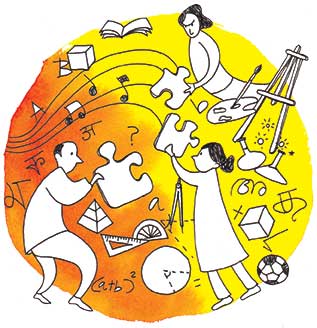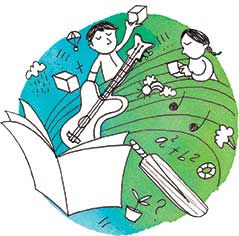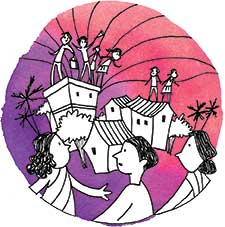Ardra Balachandran
It marks a big step in your growth when you realize that other people can help you do a better job than you could do alone, said Andrew Carnegie, founder of Carnegie Mellon University and a renowned philanthropist. There is no dearth of quotes on the effectiveness of team work, and yet, one of the noblest jobs in the world is largely an “independent” and “isolated” pursuit. The main chunk of what we do as teachers – go to classrooms and guide students through knowledge – we do it alone.
When the job in question is that of moulding future generations, isn’t “all hands on deck” the way to be? How well are we teaming up for the sake of our students?
Teaming up for the core job
When it comes to academic matters, teachers in Kerala still function like islands, and this is particularly the case in government and aided schools. Apart from a broad annual plan discussed at the beginning of every year, lesson plans and modes of delivery are left to individual teacher discretion in most schools. Betsy Jacob, a chemistry teacher at St. Augustine’s Girls Higher Secondary School, Kothamangalam, says that there is an online platform provided by the Kerala government called Samagra, where teachers are expected to upload their lesson plans regularly. But even this exercise, to be done at an individual level, does not happen properly. The fact of the matter is, very few people update their own lesson plans, let alone collaborate with others to rework their approaches.
 Dr. Lakshmi Anandavally, Assistant Professor at NSS Training College, Pandalam, has been teaching B.Ed. students for 19 years now. She says that there is a lot of emphasis on team work during teacher training. The idea is that different subject teachers come together to deliver one concept; the eye, for example. Biology and physics teachers can deliver this concept together; language teachers can add something on visual aesthetics. To equip teachers with the skill to do this, developing lesson plans is a two-step process during the B.Ed. programme. First, they are made to conduct group discussions on various topics. Based on the inputs they receive from these sessions, they proceed to make individual lesson plans. But Lakshmi believes that there is a disconnect between what teachers are trained for and what they get to do when they reach their schools. “Once on the ground, the thrust is always on finishing portions and it is a race that hardly leaves any room for collaborative effort,” she laments.
Dr. Lakshmi Anandavally, Assistant Professor at NSS Training College, Pandalam, has been teaching B.Ed. students for 19 years now. She says that there is a lot of emphasis on team work during teacher training. The idea is that different subject teachers come together to deliver one concept; the eye, for example. Biology and physics teachers can deliver this concept together; language teachers can add something on visual aesthetics. To equip teachers with the skill to do this, developing lesson plans is a two-step process during the B.Ed. programme. First, they are made to conduct group discussions on various topics. Based on the inputs they receive from these sessions, they proceed to make individual lesson plans. But Lakshmi believes that there is a disconnect between what teachers are trained for and what they get to do when they reach their schools. “Once on the ground, the thrust is always on finishing portions and it is a race that hardly leaves any room for collaborative effort,” she laments.
Private schools do this differently though. At Christ Nagar International School, Thiruvananthapuram, where Cambridge syllabus is followed, there is a well laid out process. Teachers have access to a ‘Teacher Support Website’, a platform to interact with educators from world over. Subject HODs are the local administrators of this website and they can see which teachers have logged in to utilise the resources. Learnings from the website are discussed at the monthly subject meetings; reports from these meetings are given to the principal; the principal then convenes another monthly meeting of all teachers. This becomes the platform where best practices are discussed and decided collectively, says Uma Radhakrishnan, who retired from this school last year as the chemistry HOD.
When asked “how do teachers work collectively?” Shirly Somasundaran wondered for a good 30 seconds if there is any other way to go about it. She is the principal of the kindergarten section at Vidyodaya, a private CBSE school in Kochi. They have a mandatory preparatory period just before the beginning of every academic year. It includes a week of Faculty Improvement Training (FIT) where teachers are exposed to the latest methods in the global education scene through resource persons. At the end of the FIT, teachers huddle for 3-4 days and make an academic plan for the year wherein learnings from the training have to be featured.
Asha Vinod has been teaching chemistry at Chinmaya Vidyalaya, Kochi, for 19 years. She says there is a move to work on lesson plans collectively after a teacher who came for an inspection suggested an alternative model of ‘value lesson packaging’. For example, while teaching about covalent bond, one can correlate to the value of sharing. This approach can be adopted efficiently only when multiple brains work together and a comprehensive lesson plan thus arrived at can be used by all the teachers.
Remedial action force
One academic activity, which teachers across the school spectrum undertake, is remedial coaching. Whether it is a modified transaction strategy required during the revision phase for students appearing for board exams, or extra coaching given for weaker students all through the year, teachers become a collective force to ensure that students achieve their academic goals. This is similar to the decades old American system of ‘Teacher Assisted Teams’ which act as a pre-referral support system for students at risk for school failure.
Anjali M. Antony, who works at St. George Higher Secondary School in Vazhathoppu, Idukki, says: “In the third term, students are grouped into three categories based on performance. All English teachers come together and divide modules among ourselves for each group.” In the usual system where one subject in one class is dealt by one single teacher, this addendum of “grouping and shuffling” is a value addition, and at the end, every teacher would have taught almost every student in a batch. But A.P. Nandinikutty, principal of S.D.V. Boys Higher Secondary School, Alappuzha, tried to implement this in her school last year and only the commerce batches were ready to adopt it. Teachers of the science batches maintained that they want to do revisions only for their “own classes”. Clearly, not all teachers have an attitude of team spirit.
Sometimes, remedial coaching extends to hours beyond the call of duty. In St. Augustine’s Girls Higher Secondary School, Kothamangalam, where Betsy teaches, there is a scheme for poor students to study free of cost. They have many children from Kuttampuzha Adivasi colony who need more intensive support and teachers even work on Saturdays and holidays to ensure that they catch up.
Learning beyond the books
There are several initiatives from the government to ensure that students become well-rounded individuals through their schooling period. The Additional Skill Acquisition Programme (ASAP), for example, brings a resource person to all government and aided schools to help them develop some soft skills. But it is the teachers in the respective schools who coordinate and facilitate the different activities which include field surveys, crisis management, product creation etc.
 The education department publishes an annual calendar with important days on which schools are expected to organise special educative activities and give reports. The recent solar eclipse on December 26th is a good example. Teachers have limitless possibilities to collaborate and make these days memorable for children with profound learning. There is another programme which requires schools to identify the talented people in their localities. Naturally, teachers take the lead in this too to coordinate students to visit them in smaller groups, so that they get to interact with them and document their experiences – as text-based reports or short films – to be brought back to the school and shared with everyone.
The education department publishes an annual calendar with important days on which schools are expected to organise special educative activities and give reports. The recent solar eclipse on December 26th is a good example. Teachers have limitless possibilities to collaborate and make these days memorable for children with profound learning. There is another programme which requires schools to identify the talented people in their localities. Naturally, teachers take the lead in this too to coordinate students to visit them in smaller groups, so that they get to interact with them and document their experiences – as text-based reports or short films – to be brought back to the school and shared with everyone.
Government Higher Secondary School, Karaparamba, Kozhikode, is another testament to a brilliant team effort from teachers. Twelve years ago, it was dilapidated and going to be shut down with the student strength under 90. With the support of the MLA, the entire campus was rebuilt adhering to green protocol with partnership from various public agencies. Brijesh Shaijal who led the reconstruction process notes: “Teachers formed the core team which effected an overhaul that constituted everything from uniforms to administration systems. They helped with training programmes to empower students with ideas like respecting resources, building a sense of ownership, etc.”
Extra-curricular activities = extra team work
Kerala’s annual state youth festival, with art and literary competitions for high school and higher secondary students in the state syllabus schools, is Asia’s largest contest platform for youth. Participation and prize winning brings grace marks for students, of course. But it is celebrated well beyond that and is a matter of prestige for many schools; a spirit that is worn on the sleeve by the teachers too.
Steena Davis is proud that her school wins prizes regularly, and behind the students’ stellar performance is the concerted efforts of the teachers. “We assign one teacher to every individual item (poetry writing etc.) and a group of at least three teachers for every group item. From identifying experts from outside who can train the students to coordinating all the paraphernalia of music, makeup and costumes, these teacher teams do them all. The process starts right at the beginning of every academic year when we start scouting for new talents,” she gleams.
There are also work experience fairs every year. While one teacher may be in charge of each item that goes for competition outside the school, it is always the ideas and effort of many teachers put together that leads to a good performance from the students. “We are a school with great strength and we perform consistently well in work experience competitions and youth festivals,” beams P.P. Shalini, a teacher from Government LP School, Kalarkod.
Yearly events like Annual Day and Sports Day are obvious occasions when teachers team up to bring out the best in children. In addition, all schools have clubs and committees of various kinds – some are elected every year, some once in five years – but there are these teams of teachers working on everything from arts and nature to career guidance and discipline.
Inculcating social responsibility
Kerala witnessed the worst natural calamity of a hundred years in 2018, in the form of a mammoth flood. During that time, all the schools in Kerala – the teachers, the students and the parents – rose beyond measure, teaming up for consolidated relief efforts.
At St. Ignatius School, Kanjiramattam, where V. Jayalakshmi teaches malayalam, teachers identified the students whose houses had been affected and coordinated the rest of the students to clear debris. But she says that activities to inculcate social responsibility in children are ongoing in most schools, especially through the projects of the National Service Scheme (NSS). From training the students to bringing forth new sustenance methods in the villages they adopt (hen farming, for example), teachers take a lion’s share of responsibilities.
There are also programmes led by major media houses; like Student Empowerment for Environmental Development (SEED) by the Mathrubhumi group and Nalla Paadam, a project to promote social and cultural activities in schools by channelizing youth energy, by the Malayala Manorama group; both of which use teacher teams to facilitate their activities. Steena’s school runs a full-fledged organic farm under the aegis of SEED and is also home to two Red Cross units and two scout and guide units – all of which are impossible without teachers playing key roles.
 Team ‘home work’
Team ‘home work’
Efforts of Team Teachers often extend beyond the walls of the school. In the last two years, the teachers of St. George Higher Secondary School, Cheruthoni, have been visiting every student’s house at least once in the two-year period of plus two, says Anjali. Two to three teachers visit as a group and as per convenience.
Dr. Lakshmi says that B.Ed. training equips teachers to identify the root cause beneath the problematic behaviour in students. It could be a broken family background to a physical illness such as learning disabilities that causes students to be distracted in class or perform poorly in exams. “We have conscientisation programmes where teachers develop the skill to identify these issues and to create and deliver awareness programmes, as a team,” she says.
Lakshmi Anil, an English teacher, talks about an unofficial initiative among her friends at NSS Boys High School, Changanacherry. They started conducting informal sessions for girls on menstrual hygiene and reproductive health awareness after a case of a child’s pregnancy came to light, and her own father was found to be the culprit. Having to constantly deal with substance abuse issues is yet another task for her and her colleagues.
A similar problem is expressed by Manju N., an English teacher who works at Paliyam Government Higher Secondary School, North Paravoor. There are 45 students, who appear on the excise hitlist for being peddlers, in her school. While there is a school protection group with representatives from teachers, the police force and the local community (like autorickshaw drivers), Manju does not think enough is being done. She believes that this issue feeds a vicious cycle which even parents do not want students to exit since they contribute to family income, and she is quite disappointed by the inefficiency of teacher engagement because everyone is not on the same page.
Prabha Vasudev works at Government Model Vocational Higher Secondary School, Ambalapuzha, and paints a brighter picture. “If we identify a problem child, which is most often done by the class teacher, we discuss that in the staff room. It is often after considering suggestions from everyone that we decide on a course of action which may include home visits and therapy referrals,” she says. In her school, PTA gets involved only if the issue is really big – for example, in connection with the fundraising for a child’s cancer treatment, PTA worked actively – but otherwise, it is just the teachers who come together for most such initiatives. Their school also has a Friendship Club system which consists of clusters of 8-10 students, each one monitored by a teacher. “Everything from individual anxiety to problems at home is discussed on this platform,” asserts Prabha.
Then there are teachers who visit homes for an entirely different purpose. For Shalini, who teaches at Government LP School, Kalarkode, one earnest group activity is canvassing students for the new academic year. “Every December, we set out in groups to visit anganvaadis, nearby houses etc. to prepare a list of potential students. When we visit the house, we also get to know the socio-economic condition of the family,” she shares.
Standardisation versus originality
While the downside of team work may not be obvious, Shirly Somasundaran has a different point of view. Their school is ISO certified, and for periodic renewal of certification, there must be strict adherence to quality. Shirly believes that this has forced them to work in teams and deliver knowledge sticking to processes. This ‘focus on process’ ensures uniform delivery across class divisions, sure. But do we want that? Don’t we want our teachers to have the liberty to innovate and add that individual touch while teaching students? She is quick to add though: “when you think of all those teachers who are averse to working in teams because of sheer laziness, process becomes a great leveller. So in this case, pros clearly outweigh the cons.”
Standing amidst the ashes of a bombed school in war-stricken Japan, Sosaku Kobayashi, the principal of Tomoe School, asks his students including Totto-chan: “What type of school would you like to have next?” A good teacher is all about this perspective of positivity, in a nutshell. Once this is in place, forging bonds among colleagues to bring out the best version of students will happen naturally; because ultimately, we all know that it indeed takes a village to raise a child.
The author is a media professional based in Kochi. A post graduate in Mass Communication from the University of Hyderabad with an M.Phil. in Gender Studies, she writes on topics ranging from gender and education to food and entertainment. She can be reached at ardramaanasam@gmail.com.
